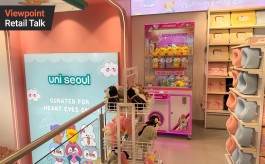Why regional market is a growth driver for the retail design industry and more…
By N Jayalakshmi | May 31, 2024
The next conversation in ‘Business of Design’ has Shyam Sunder K, Founder, Principal Architect & MD - 4Dimensions Retail Design, sharing his keen insights on the huge potential in India’s regional retail markets, the challenge of finding retail design talent, and more…

The traditional side of India has always been a force to reckon with, whether socially or economically. And in the context of retail, traditional or regional retailers are also emerging as a source of newer and bigger opportunities for the retail design industry and its eco-system. As Shyam Sunder K, Founder, Principal Architect & MD - 4Dimensions Retail Design, tells Retail4Growth in this exclusive conversation as part of ‘Business of Design’ series, “I would say that the opportunity in regional retail market is much bigger compared to corporate or national brands. In fact, Many regional retail companies have their revenue growing at an average year-on-year rate of 15-20%”.
Indeed, as Shyam points out, there are interesting trends happening today - regional retailers trying to establish themselves in a space dominated by national brands and national brands expanding to regional markets. In the midst of this, traditional or regional retailers are also changing the way they are approaching their business. Many of them are becoming public limited companies and moving from being a family driven business to a more process-driven one.
Shyam’s insights are of course based on his first-hand experience of working with regional retailers, many of whom he says, are fast adapting to new market trends and willing to spend more on improving their customer experience in store. “They are willing to spend more on their stores to draw in a younger audience and their decision making is much simpler compared to national level brands.”
No frills, only experience
Another important insight that Shyam shares, while talking about regional retailers, is their focus on curating experiences, rather than on interiors. “Regional retailers don’t spend unnecessarily on interiors, their focus is on keeping the interiors simple, clean and functional. They focus on spending more on experiences that can be created within the store - like play areas for kids, experiential cafes, digital interfaces, etc.”
The pressure of cost cuts
For retail designers and solution suppliers, the opportunity posed by regional retail is particularly significant given the rising cost pressures. As Shyam says, “National brands tend to focus on cost cutting and that puts too much pressure on retail designers and solution providers. Also, with cost cutting, compromise becomes inevitable.”
He adds, “My suggestion to national brands is to look at the situation as a win-win one, wherein the partners and suppliers can also win.”
Talent – the other big challenge
While mounting cost continues to be a challenge, the other big challenge for the retail design industry is finding good talent, says Shyam, reflecting the views of many others in the industry. “The biggest challenge today for the industry is in terms of human resource - finding the right design talent. And this is very critical as ours is a service industry. So the onus is on us to train and groom designers,” says Shyam. In fact, grooming design talent and creating a human resource hub for this eco system tops Shyam’s current wish list. “Everyone in the industry can come together and collaborate towards this so we not only groom new design talent, but also leverage it for our businesses.”
But these challenges notwithstanding, Shyam is pretty optimistic about the Indian retail design industry’s growth. “Based on my observations and industry interactions¸ I would say that the whole eco-system has grown by an average of at least 15 % this year and it will continue to grow.” Indeed, the Indian retail design industry, which is pegged by most industry players at about Rs 100-150 crore, has huge potential to grow, provided it is driven by cost-efficient innovation and exploration of new markets, as Shyam sums up.




_140_270.jpg)
_140_270.jpg)



Comments